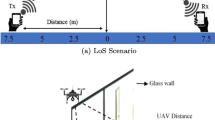Abstract
As a result of unmanned aerial vehicles being widely used in different areas, studies about increasing the autonomous capabilities of unmanned aerial vehicles are gaining momentum. Today, unmanned aerial vehicle platforms are especially used in reconnaissance, surveillance and communications areas. In this study, in order to achieve continuous long-range communication relay infrastructure, artificial potential field based path planning of Unmanned Aerial Vehicles is discussed. A novel dynamic approach to relay-chain concept is proposed to maintain the communication between vehicles. Besides dynamically keeping vehicles in range and appropriate position to maintain communication relay, artificial potential field based path planning also provides collision avoidance system. The performance of the proposed system is measured by applying a simulation under the Matlab Simulink and Network Simulator environment. Artificial potential field based flight patterns are generated in Matlab, and performance of the communication between vehicles is measured in Network Simulation environment. Finally the simulation results show that an airborne communication relay can be established autonomously by using artificial potential filed based autonomous path planning approach. Continues state communication is provided by obtaining a resistant communication relay which depends on artificial potential field based positioning algorithm.
Similar content being viewed by others
References
Nguyen, H.G., Pezeshkian, N., Gupta, A., Farrington, N.: Maintaining communication link for a robot operating in a hazardous environment. ANS 10th Int. Conf. on Robotics and Remote Systems for Hazardous Environments, Gainesville, FL, March 28–31 (2004)
de Freitas, E.P., et al.: “UAV Relay Network to Support WSN Connectivity” Ultra Modern Telecommunications and Control Systems and Workshops (ICUMT), 2010 International Congress on, Oct.,18–20 (2010)
Pinkney, F., Hampel, D., DiPierro, S., Abbe, B.S., Sheha, M.: UAV communications payload development. In: MILCOM 97 Proceedings, pp. 403–407, 2–5 Nov 1997
Northrop Grumman Web Site, “UAV communications relay” www.es.northropgrumman.com/solutions/uavcommrelay/. Accessed 13 Feb 2011
Burdakov, O., Doherty, P., Holmberg, K., Kvarnstrom, J., Olsson, P.-M.: Positioning unmanned aerial vehicles as communication relays for surveillance tasks. In: Robotics: Science and Systems 5th Conference, June 28 - July 1, (2009)
Vaščák, J.: Navigation of mobile robots using potential fields and computational intelligence means. Acta Polytech. Hung. 4(1), 63–74 (2007)
Kim, J.O., Khosla, P.K.: Real time obstacle avoidance using harmonic potential fuctions. IEEE Trans. Robot. Autom. 8 (1992)
Khatib, O.: Real time obstacle avoidance for manipulators and mobile robots. Int. J. Rob. Res. 5–1, 90–99 (1986)
Garcia, R., Barnes, L.: Multi-UAV simulator utilizing X-plane. J. Intell. Robot. Syst. 57(1–4), 393–406 (2010)
Barnes, L., Alvis, W., Fields, M., Valavanis, K., Moreno, W.: Heterogeneous swarm formation control with potential fields formed by bivariate normal functions. In: 14th Mediterranean Conference on Control and Automation, MED ’06, 28–30 June (2006)
Koditschek, D.E.: Exact robot navigation by means of potential functions: some topological considerations. IEEE Int. Conf. Robot. Autom. 1–6 (1987)
Krough, B.H., Thorpe, C.E.: Integrated path planning and dynamic steering control for autonomous vehicles. IEEE Int. Conf. Robot. Autom. 1664–1669 (1986)
Brooks, R.A.: A robust layered control systems for a mobile robot. IEEE Int. Conf. Robot. Autom. 2(1), 14–23 (1986)
Arkin, R.C.: Towards cosmopolitan robots: intelligent navigation in extended man-made environments. Technical reports COINS Department, University of Massachusetts (1987)
Borenstein, J., Koren, Y.: The vector field histograms fast obstacle avoidance for mobile robots. IEEE Int. Conf. Robot. Autom. 7, 278–288 (1991)
Connoly, C.I.: Harmonic functions and collision probabilities. Int. J. Rob. Res. 16–4, 497–507 (1997)
Masoud, A.A., Masoud, S.A.: Motion planning in the presence of directional and obstacle avoidance constraints using nonlinear, anisotropic, harmonic potential fields. In: Proceedings of the IEEE International Conference on Robotics & Automation (2000)
Faria, G., Romero, R.A.F., Prestes, E., Idiart, M.A.P.: Comparing harmonic functions and potential fields in the trajectory control of mobile robots. In: Proceedings of the IEEE, Conference on Robotics, Automation and Mechatronics (2004)
Guldnef, J., Utkin, V.I., Hashimoto, H., Harashima, F.: Obstacle avoidance in Rn based on artificial harmonic potential fields. IEEE Int. Conf. Robot. Autom. (1995)
Author information
Authors and Affiliations
Corresponding author
Rights and permissions
About this article
Cite this article
Cetin, O., Zagli, I. Continuous Airborne Communication Relay Approach Using Unmanned Aerial Vehicles. J Intell Robot Syst 65, 549–562 (2012). https://doi.org/10.1007/s10846-011-9556-6
Received:
Accepted:
Published:
Issue Date:
DOI: https://doi.org/10.1007/s10846-011-9556-6




